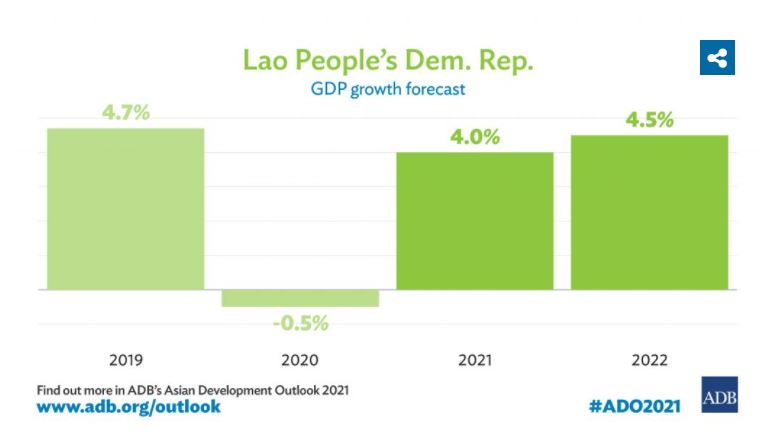VIENTIANE, LAO PEOPLE’S DEMOCRATIC REPUBLIC (28 April 2020) — The Lao People’s Democratic Republic’s (Lao PDR) economy is expected to grow at 4.0% in 2021 and 4.5% in 2022, supported by improved agriculture production and sustained power generation, which will offset a slow recovery in services amid the coronavirus disease (COVID-19) pandemic, according to a new report by the Asian Development Bank (ADB) released today.
The projected recovery follows a 0.5% contraction last year in Lao PDR’s economy, following a growth rate of 4.7% in 2019, according to the Asian Development Outlook (ADO) 2021.
“Growth is gaining momentum in the Lao PDR, but new COVID-19 outbreaks, along with structural challenges, pose a threat to the country’s recovery,” said ADB Country Director for the Lao PDR Sonomi Tanaka. “A swift vaccine rollout, accompanied by measures to strengthen macroeconomic management and improve investor sentiment, is needed to support the economic recovery and safeguard the welfare of households.”
Severe restrictions on tourists in 2020 helped avert a large-scale public health crisis in the Lao PDR but stifled domestic and external demand, resulting in a rise in unemployment. Public finances were hard hit, with ratings agencies downgrading the Government of the Lao PDR’s credit rating because of rising external liquidity pressure amid limited refinancing options.
A moderate recovery in agriculture is expected this year, largely due to growth in livestock trade. But the planting of food crops has been delayed by cooler weather and water shortages. Industry growth will be boosted by increased electricity production. Continuing investment in large-scale infrastructure, mining, and urban property is expected in 2021 and 2022, which will create jobs and support household purchasing power.
Growth in services in 2021 will be supported by a recovery in domestic consumption from the completion of strategic infrastructure investments, such as the Vientiane–Vang Vieng expressway, which will boost domestic hospitality industries. With international tourism for business and leisure normalizing in 2022, the drivers of economic recovery in the medium term are expected to be wholesale and retail trade, transportation, and communications.
Rising food prices due to diseases and natural disasters pushed up the Lao PDR’s inflation to 5.1% in 2020. Inflation will drop to 4.5% in 2021, before rising to 5.0% in 2022, as pressure from imported goods on the Lao kip’s depreciation is partially offset by improved domestic production.
Ongoing difficulties in domestic resource mobilization, which is associated with structural challenges and weak governance, are being exacerbated by the COVID-19 pandemic. The country’s fiscal deficit will likely remain elevated in the near term. The Lao PDR’s macroeconomic framework remains fragile, given the country’s high risk of debt distress, increased debt-service pressure, and potentially higher refinancing rates. To create the fiscal space needed for more resilient growth, reforms for better transparency and management of public debt are essential.
ADB is committed to achieving a prosperous, inclusive, resilient, and sustainable Asia and the Pacific, while sustaining its efforts to eradicate extreme poverty. Established in 1966, it is owned by 68 members—49 from the region.
Source: https://www.adb.org/lo/news/macroeconomic-management-key-recovery-lao-pdr-adb
Please share your feedback below and help us improve our content.

